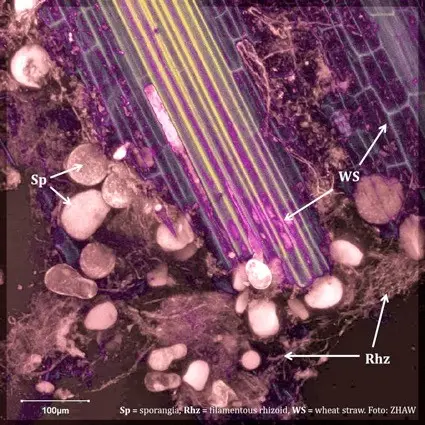Unleashing the hidden potential of the anaerobic fungi (Neocallimastigomycota)
Description
The microorganisms thriving in the ruminant’s digestive tract deliver the metabolic potential for degrading recalcitrant lignocellulose-rich organic matter and rendering it digestible. Amongst the microbiota thriving in the rumen, anaerobic fungi (AF) with the unpronounceable name Neocallimastigomycota host a complex array of enzymes that are especially adapted for degradation of lignocellulosic biomass like straw. In addition, their appressoria attach to the macromolecule structures and physically penetrate them, thus enhancing the enzymatic action.Cultivation of these fungi has often ended in frustration for researchers as the understanding of cultivation requirements is very poor. However, scientists see the great potential of these organisms for biotechnological use, in particular for the utilization of lignocellulosic residues (LCR) in closed loop recycling management. For this project, a consortium from Austria (leading agency; PI: Dr. Sabine Marie Podmirseg), Germany (PI: Dr. Michael Lebuhn) and Switzerland (PI: Prof. Urs Baier), all engaged in the harnessing of AF, is cooperating in close connection with research groups in the United Kingdom and in the Czech Republic. The overarching aim of the proposed project will be to remove existing methodological obstacles preventing the biotechnological utilization of anaerobic fungi. For that purpose, the consortium starts with the crucial basics, explores the cultivation requirements of Neocallimastigomycota, develops suitable culturing and detection methods and finally evaluates their biotechnological application for LCR disintegration.The working hypotheses are, amongst others: (i) the ecological niche for AF is larger than assumed to date; (ii) distinct requirements for micronutrients or supplements have to be met for long-time cultivation; (iii) cultivation without rumen fluid is possible for many strains; (iv) novel AF can be isolated from various also non-rumen habitats. The project will combine classical microbiological methods (microscopy, batch and continuous cultivation, enzymology) with molecular approaches (fluorescence in situ hybridization, quantitative PCR, direct RNA and next generation sequencing). It is expected to develop suitable protocols for the cultivation of anaerobic fungi and provide the basics for up-scaled production. The project’s goal is to enable researchers and the society to make use of the AF for energetic and material use of LCR.
Key Data
Projectlead
Dr. Sabine Podmirseg, Dr. Rolf Warthmann
Deputy Projectlead
Prof. Dr. Urs Baier
Co-Projectlead
Prof. Dr. Heribert Insam, Prof. Dr. Michael Lebuhn
Project team
Akshay Joshi, Lona Mosberger, Katharina Schmid Lüdi
Project partners
Universität Innsbruck; Bayerische Landesanstalt für Landwirtschaft
Project status
completed, 12/2018 - 05/2022
Institute/Centre
Institute of Chemistry and Biotechnology (ICBT)
Funding partner
SNF-Projektförderung / Projekt Nr. 179552; Deutsche Forschungsgemeinschaft DFG / Projekt Nr. 399668713; Fonds zur Förderung der wissenschaftlichen Forschung Österreich
Project budget
1'198'889 EUR
Further documents and links
Publications
-
Simultaneous metabarcoding and quantification of neocallimastigomycetes from environmental samples : insights into community composition and novel lineages
2022 Young, Diana; Joshi, Akshay; Huang, Liren; Munk, Bernhard; Wurzbacher, Christian; Youssef, Noha H; Elshahed, Mostafa S; Moon, Christina D; Ochsenreither, Katrin; Griffith, Gareth W; Callaghan, Tony M; Sczyrba, Alexander; Lebuhn, Michael; Flad, Veronika
-
No time to die : comparative study on preservation protocols for anaerobic fungi
2022 Vinzelj, Julia; Joshi, Akshay; Young, Diana; Begovic, Ljubica; Peer, Nico; Mosberger, Lona; Luedi, Katharina Cécile Schmid; Insam, Heribert; Flad, Veronika; Nagler, Magdalena; Podmirseg, Sabine Marie
-
Effect of growth media on the diversity of Neocallimastigomycetes from non-rumen habitats
2022 Joshi, Akshay; Young, Diana; Huang, Liren; Mosberger, Lona; Munk, Bernhard; Vinzelj, Julia; Flad, Veronika; Sczyrba, Alexander; Griffith, Gareth W.; Podmirseg, Sabine Marie; Warthmann, Rolf; Lebuhn, Michael; Insam, Heribert
-
Employing anaerobic fungi in biogas production : challenges & opportunities
2020 Vinzelj, Julia; Joshi, Akshay; Insam, Heribert; Podmirseg, Sabine Marie

